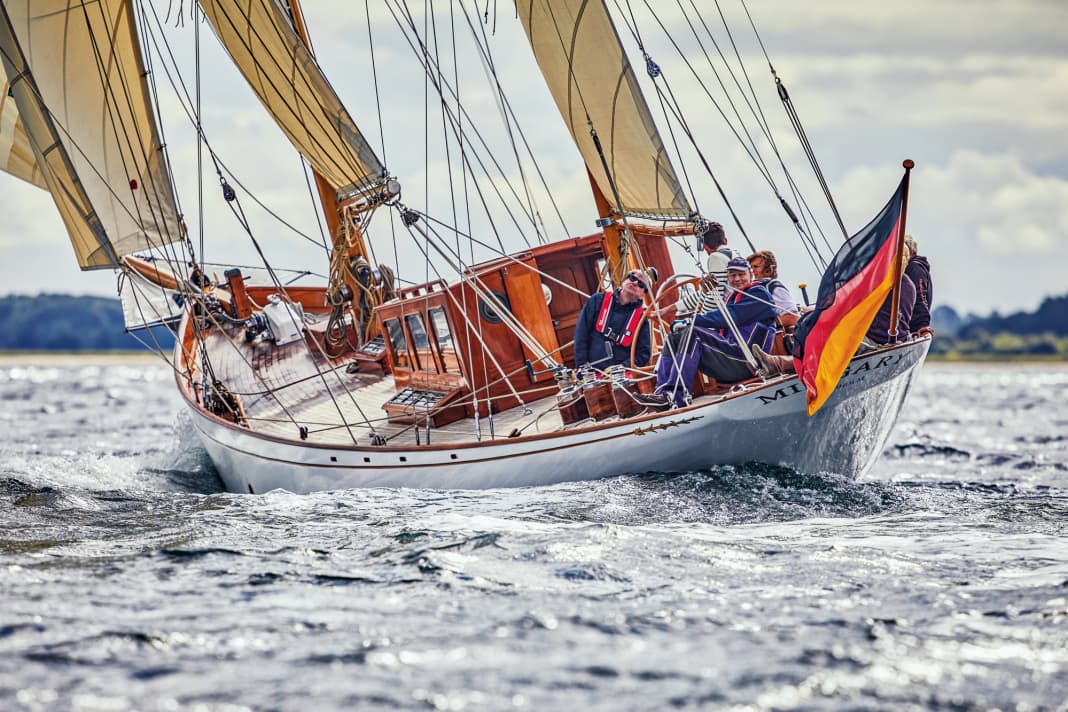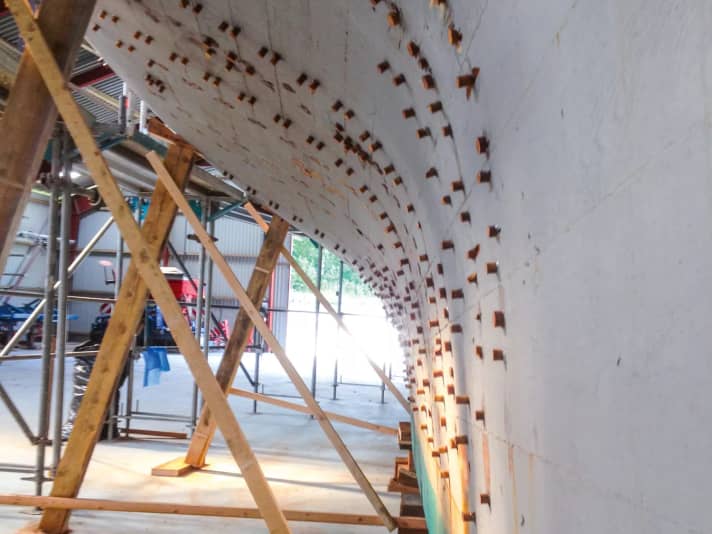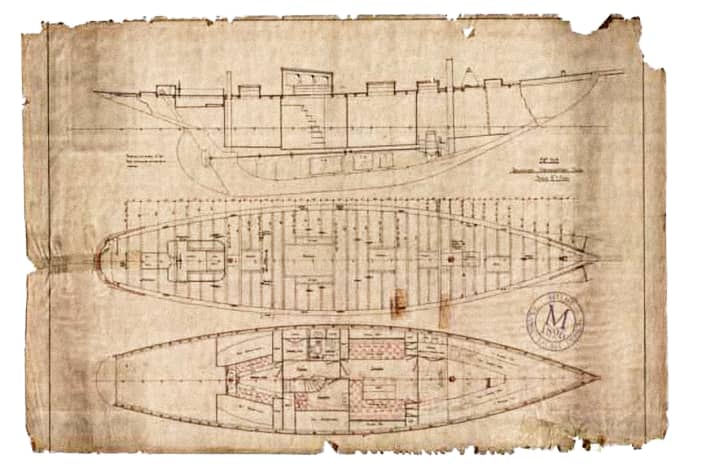





Only a rickety plank of rough, untreated wood has to be crossed to get from Maasholm to Victorian England. If you want to travel back in time, you have to go to the Modersitzky boatyard. There they will discover a monumental rig consisting of two shiny honey-coloured masts at the water's edge and, as they approach the scenario, they will find themselves standing in front of "Mingary", a 20-metre gentlemen's yacht built in 1929.
Owner Christian Scheidtmann welcomes you on board. The passionate woodworker took the ship into his care in 2012 and gave it a new lease of life. It took the enthusiast just three years to comprehensively restore the mighty ship. Since 2015, "Mingary" has graced the waters of northern Germany in new splendour. Scheidtmann received the restoration prize for his work at the German Classics 2016 in Laboe. No other classic in the North German fleet represents the era of its Scottish designer Alfred Mylne and his contemporaries like "Mingary".
"Mingary" is an impressive appearance
"The yachts from the 1920s and 1930s have always fascinated me," says Scheidtmann. He has taken a seat in the deckhouse and talks enthusiastically about the picturesque Schleil landscape behind the large windows.
Her size alone - the hull measures more than 18 metres above deck - is awe-inspiring. Her lines are elegant and strong, as if she had just been completed. The deck is completely free except for the skylights and the man-high deckhouse, by which she is recognisable as a child of her time. Ships like this, says the owner, have been around for a hundred years and have always been admired for their appearance. "That's what fascinates me so much: that something was created with these yachts that has never lost its value." Unlike pieces of furniture, which are subject to fashion and only experience a renaissance with luck, the classics of the pre-war period have always found owners who have succumbed to their charm and have preserved the timeless work at great expense.
From the windows, the view sweeps over the immaculate Burmese teak stave deck and the glossy lacquered surfaces of the gunwale and gunwale. "The 'Mingary' has always been cherished and cared for," says Scheidtmann, who takes obvious pleasure in continuing this task.
"Grace, Pace and Space" - Grace, speed and space
The 20 metre long cruiser yacht was built in 1929 for John and Alan McKean at Bute Slip Dock on the River Clyde in Scotland. Alfred Mylne's brother Charles had been running the joint shipyard on the island of Bute since 1911. From then on, it was the most important building site for the internationally operating designer. Located not far from his Glasgow office, he was able to see how his ideas were realised, develop new ones and influence the construction process.
His construction number 319 embodies Alfred Mylne's philosophy to perfection. "Grace, Pace and Space" - the designer believes that this triad contains everything that makes a cruising yacht for a gentleman. Their charisma should inspire you to treat them well. Effortlessly achievable speed should motivate people to sail her on voyages and regattas. A comfortable interior should ensure a sense of well-being on board.
Owner Christian Scheidtmann particularly appreciates another of his thoughts. "I've done a lot of research into Mylne and its philosophy," he says. Scheidtmann radiates calm as he talks in a gentle voice. Anyone sitting opposite the bearded guy on board can hardly imagine that someone like him would go to Mylne's office and commission a large cruiser yacht. An unpretentious guy who appears on board in carpenter's trousers rather than a white cap. And yet he is very much at home in Mylne's world of thought.
When the metre formula was developed in 1906, according to which it should finally be possible to race internationally, Mylne sat at the table - and observed in the following years how short-lived boat building became. The metre yachts that he elaborately constructs are sold again after just one season. This is a horror for the meticulous engineer.
"Mylne didn't want sailing to become so elitist," says Scheidtmann. "He wanted to create sustainable boats. And that's when he started designing the large cruiser yachts like 'Mingary'."
The designer was an unrecognised genius
The name Alfred Mylne stands for these ships like no other. However, the rest of his work was overshadowed during his lifetime by his rivals William Fife III and Charles Nicholson. In retrospect, however, Mylne is regarded by some as an unrecognised genius.
Alfred Mylne was born in 1872 and grew up in middle-class circumstances. He studied at the Technical University in Glasgow and joined the firm of designer George Lennox Watson in 1892. The boat builder founded the first yacht design office in the whole of Great Britain in 1873 and quickly gained an international reputation. His designs for the America's Cup ended up influencing the competition for decades. When Mylne approached him, Watson was busy designing the "HMY Britannia" for the future King Edward VII. Mylne nevertheless set up his own office, also in Glasgow, just four years later.

There are plenty of customers. Sailing is booming on the Clyde as a leisure activity for the burgeoning industrialised society. A wide variety of boats and yachts are being sailed, with local standardised classes, construction classes that demand a lot from the designer's skills, being extremely popular. William Fife III is already an established competitor on site, but chroniclers describe the co-operation as friendly.
While Fife designs his yachts intuitively in the old school, Mylne, who studied engineering, favours a scientific approach. His designs follow elaborate calculations, just as his role model Watson taught him. Despite the elegance of their lines, Mylne's cracks are fuller than those of his competitor Fife. And yet they are considered hard to beat.
Owner Christian Scheidtmann has a soft spot for classic yachts
Christian Scheidtmann still likes to demonstrate this almost one hundred years after the launch of his "Mingary" when he and his crew compete in classic regattas. They often sail to the top places in their group.
Sporty sailing is in Scheidtmann's blood. He discovered his passion for water sports as a teenager while windsurfing, to which he devoted everything for many years. After completing an apprenticeship as a carpenter, however, he set up his own business and from then on devoted himself entirely to working with wood. When a friend took him sailing for the first time, it was a wooden classic on which the craftsman immediately felt at home.
The first boat he owned was also a classic yacht. Scheidtmann discovers it here, at Modersitzky, when he visits friends and immediately falls in love with the picturesque place and the landscape of the Schleil. Another friend's project led Scheidtmann to Barney Sandeman shortly afterwards. The classic yacht broker from Poole in the south of England has a ship on offer that he is to help buy and transfer. "I stayed in touch with Barney," says Scheidtmann, who has been dreaming of carrying out a restoration project himself ever since.
"Mingary's" exciting life: Mallorca, the Caribbean, Sweden
One day, he learnt from Sandeman that "Mingary" was available. Until the mid-1960s, she was based in Greenock, a town on the Clyde estuary not far from where she was built, under various owners. At the beginning of the seventies, she was moored in Palma de Mallorca under the Panamanian flag. In the mid-1980s, she underwent a comprehensive refit including a new main mast and was transferred to the Caribbean, where she ran aground in Hurricane Emily, but was shipped back to her owner's home in the south of England and repaired.
The second maiden voyage to the Mediterranean took place in 1990, later "Mingary" sailed several summers in the western Swedish archipelago. Until Scheidtmann's previous owner commissioned a comprehensive restoration from Fairly Yachts in Southampton. However, the global economic crisis left him in a tailspin and he had to abandon the refit project.
The best that is possible from a boatbuilding point of view
Barney Sandeman advises Scheidtmann to take over the ship. This yacht was the best that was possible from a boatbuilding point of view. The hull is made of teak planks on mature oak frames, the metal fittings are all made of bronze, and everything is in absolutely original condition.
Scheidtmann takes a look at the ship, which has been gutted on land for two years, and has a great deal of respect. "I really didn't want to have such a big cruiser yacht. It could easily have overwhelmed me." He spent several months carefully calculating his own work, external labour, materials and time and finally contacted Will Stirling, an English wooden boat builder who had already inspected the ship. He looks at Scheidtmann's calculations and agrees. "He assessed the cost exactly as I did." Scheidtmann is convinced of his plan, buys the boat and has it shipped to the Schlei in May 2013.
The restoration succeeds faster than planned
The fact that he managed to beat the already ambitious plan in the first summer is thanks to the spirit and creativity of his colleagues: "I found people who were very keen on the project," says Scheidtmann, who hired employees from Modersitzky and from his own joinery, as well as the British Will Stirling, who brought another colleague with him.
"I planned every working day meticulously. If it's well prepared and logistically well thought out and the discipline is right and then you have people who are consistently enthusiastic about it, then you can achieve much, much more than you think. And that's what this summer was like." This spirit can still be felt today, Scheidtmann has captured it. In his Building diary shows in elaborate film sequences how the project gained momentum back then and how the launch finally took place in autumn 2013.
"My aim is to show what a fascination these boats have for people. Everyone saw it as their boat - and didn't work for me, but for the boat. And that's how incredible performance came about."
Hardly any other boat is as well preserved as the "Mingary"
Scheidtmann is able to acquire the original plans from the Mylne archive before work begins. He realises that the dismantled interior does not correspond to the original. The hull is different; even Will Stirling, who has been working on projects like this for years, said with fascination that he knew of no other boat that had been preserved in such an original state. "Not a single plank has ever been replaced. And everything was still in order, nothing was rotten anywhere."
Not a single plank was ever replaced. And everything was still in order."
Nevertheless, the work is quite a challenge. All 42 iron floor frames are removed, levelled to their original shape, recast in silicon bronze and reinstalled. The main frames in the area of the main mast and around half of all the bent-in secondary frames have fatigue fractures and are being replaced. "Mingary" gets new keel bolts made of bronze and a new mast track made of oak. Scheidtmann is sticking to Mylne's concept when choosing the materials, as it has meant that the wooden structure has not been damaged anywhere.

Outside, the hull is completely stripped, stripped above water, caulked under water and freshly painted. On deck, the gunwales and gunwales are largely replaced, the deck itself is refitted and the deckhouse removed for transport is refitted. All painted surfaces are stripped and rebuilt. Finally, a new engine foundation and the drive are put back into the ship, then it can go into the water. In the autumn, Scheidtmann transfers the restored hull to its former home in the Ruhr area and completely refits it in just one year, including modern technology.
In summer 2014, they return to Maasholm, where the rig is overhauled and "Mingary" is rigged up again. When he and his team set sail for the first time in October 2014, Scheidtmann says, everything worked perfectly. And nothing has changed since then.
"Mingary" finds her way alone
Meanwhile, the deck is a hive of activity. The crew has arrived, it's time to sail, a trim for another classic regatta. As tarpaulins are removed and stowed away, there is laughter and a cheerful atmosphere. "I never have problems finding a crew because everyone is always up for it. And it's extremely harmonious. I always say I don't do it, the boat does it. But some people say it's also you. It's both, probably. And there are always people who like each other."
He didn't have to say it. After leaving the Schlei, the large cruiser yacht is brought under sail and on course hand in hand. The short Baltic Sea wave is barely noticeable on deck; under the press of a fresh north-westerly wind, the old lady sets off with grandeur; and only a glance at the log reveals how fast she is going. The helmsman, however, only has a supporting role. "Mingary" finds her way effortlessly on her own and can be trimmed very evenly with the sails.
It could go on like this for days. However, Scheidtmann has not yet been able to go on any big trips. The odd week's holiday trip to the waters around Funen and Zealand - but a visit to Scotland, on the River Clyde, where his ship was built and has been at home for half of its life, will have to wait a little longer.
But he will definitely come one day, with Grace, Pace and Space.
Technical data "Mingary"
- Design engineer:Alfred Mylne
- Building yard: Bute Slip Dock
- Material:Teak on oak
- Total length:20,7 m
- Length above deck:18,3 m
- Waterline length: 12,5 m
- Width:4,0 m
- Depth: 2,4 m
- Displacement: 21,8 t
- sail area: 142 square metres
- Motor:Mercedes OM 603
- Performance: 5 cylinders, 98 hp
- Further information: mingaryrestoring.wordpress.com


